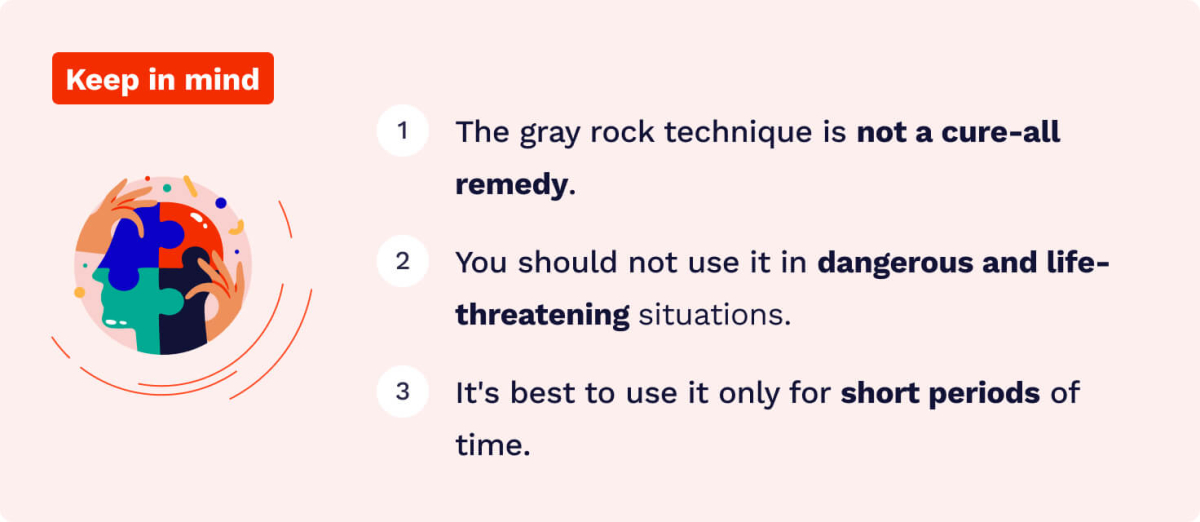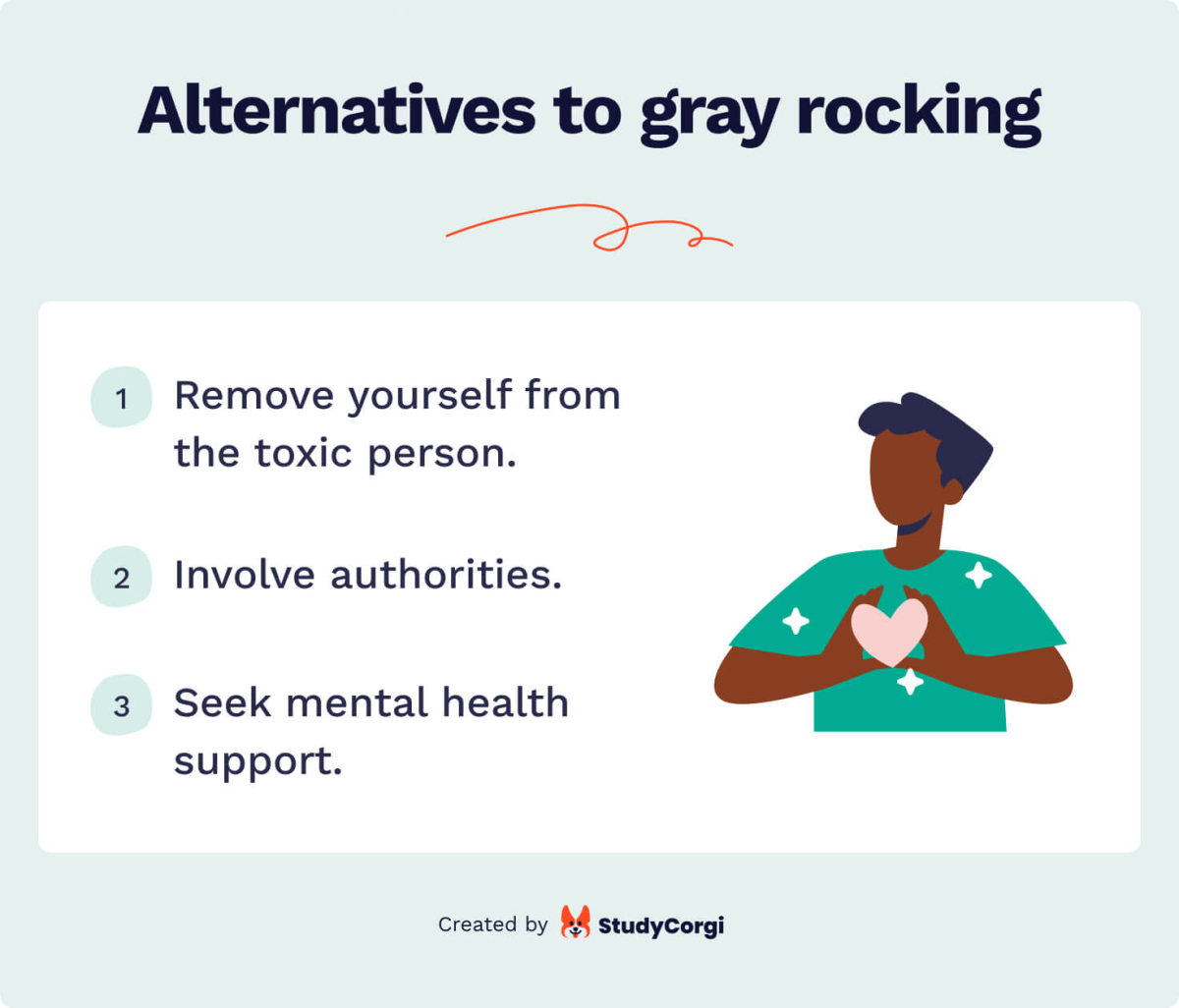Dealing with toxic, aggressive, and manipulative people is a real pain in the neck. For the most part, it is best to simply avoid them. But what if the toxic person is your colleague, classmate, or even roommate? How can you deal with them and overcome their toxicity?

Enter the gray rock method: a fantastic approach that has recently gained popularity. Basically, this technique is designed to bore and exhaust the perpetrator. Thus, with little effort, you can show your abuser that you don’t have an easy shell to crack and that their attempts at annoying you are futile.
So, what is the gray rock method, and how do you use it? Our experts will tell you all about it in this comprehensive article! There is also a bonus waiting for you in the final section, so make sure to read till the end.
🗿 What Does It Mean to “Go Gray Rock”?
The whole method is described in its name. A person using it becomes plain, boring, and “hard to move,” just like a gray rock.
The point is that toxic people need to see an emotional reaction to their provocations. If you don’t give them any response at all, they will most likely take their toxicity elsewhere.
The gray rock method comes in handy in many circumstances because, in theory, the majority of annoying and manipulative people will react the same way when a person shows no reaction to their toxicity.
Let us get a little deeper into the method, so we can see how to get the most out of it!
How It Works
The gray rock method is based on behavioral psychology, particularly the effect of so-called extinction.
Extinction denotes the end of a specific behavior when it fails to provide the desired results.
A toxic person feeds off the negative emotions of others. Simply speaking, what they want is drama. When such people understand that their chosen victim ignores them and shows no sign of stress, fear, or irritation, they experience extinction and are forced to change their tactic or look for another target.

The key to effectively dealing with annoying people is to remain calm and unaffected by their attempts to provoke a reaction. This is what the gray rock method can help you with.
Is It Effective?
As you can see, there are convincing explanations for the theoretical effectiveness of gray rocking. Many real-life examples also confirm that this method works. However, its efficacy has yet to be confirmed by research. Right now, there’s no scientific evidence in favor of this technique.
That’s why we can’t stress it enough that gray rocking needs to be handled carefully—more on that later.
💡 When to Use the Gray Rock Method
The gray rock technique is best used with people who are just unpleasant and not necessarily toxic. It’s also said to be effective against individuals with narcissistic and psychopathic tendencies. It’s a great short-term solution that can free you from their unwanted attention and even make them lose interest in you completely.
The American mental health blogger who goes under moniker Skylar first described this method online. She used it to get rid of a toxic ex. The idea of gray rocking started gaining popularity, though at first many people thought that it works only with romantic partners.
Time showed that this is not true. The technique has been successfully applied in a variety of situations outside of marriage and romantic affection, including the following relationship types:
- Between housemates who exhibit manipulative or domineering tendencies.
- With problematic or abusive coworkers that frequently try to provoke arguments or drama in the workplace.
- With seniors or head management at work.
- With pushy and opportunistic in-laws, stepparents, or other family members in situations such as family holiday gatherings.
- With elderly people who tend to impose their point of view.
- At school or college with bullies and toxic students.
- In situations of cyber bullying during online communication.
- With toxic roommates or neighbors.
- With friends who become abusive due to a difficult life period.
As you can see, gray rock communication is pretty universal and can be used in various relationships, especially those that can’t be ended quickly or ignored.
🚀 How to Use the Gray Rock Technique: 8 Best Tips
Now that you are acquainted with this fantastic technique, it is time to learn how to use it in practice. Is there someone really annoying around you? Do you want to try to get rid of them with the help of gray rocking? Well, keep reading!
In this next segment, we’ll tell you how to integrate the gray rock technique into your communication with toxic people.

1. Visualize Yourself as a Gray Rock
Literally imagine yourself as a gray and boring rock. This will help you not to stand out and be as dull as possible. You may even dress in all-gray clothing to drive the point even further. This behavior will make it more difficult for your opponent to cling to any of your features which they might use to start a toxic conversation.
2. Give Very Brief Answers
This is the trademark technique of gray rocking: giving brief replies that do not encourage your opponent to keep speaking. If that person insists on continuing the conversation, try to use short and meaningless answers like “eh” or “hmmm.” Using body language such as nodding and shrugging is also a great option.
3. Show No Emotion
Try to disengage from the situation. You know that the toxic person is saying harsh or upsetting things about you to manipulate you and elicit a response. This knowledge gives you an advantage over them. Maintain a neutral expression and a calm tone and use evasive answers. No matter how you are feeling, try to avoid escalating negative situations.
4. Keep Your Personal Information to Yourself
Here is another tip on how to be dull on purpose: not to disclose anything that’s happening in your life, whether positive or negative. Try to come up with only the most tedious and ordinary things to share with this person.
It’s also important to avoid asking your opponent about anything interesting. It will make them stop trying to talk to you, as they will be bored by the conversation.
5. Avoid Eye Contact
As you already know, toxic people always want to see a reaction to their actions. Being able to look you in the eye allows them to read your emotional state and understand that they have elicited a response. However, if you don’t look them directly in the eye, they will lose this ability and will assume you’re disinterested or bored.
6. Use Excuses if Necessary
You can use a brief excuse like “I’m late, gotta go” to end a conversation. It will allow you to flee under a discrete pretext. Don’t worry if it’s a lie: you have a good reason to say it!
7. Distract Yourself
If it is difficult for you to disengage from the situation, try to occupy yourself with something while dealing with the toxic person. This will also help you keep the negative emotions from taking over.
For example, when having an unpleasant interaction, you may try reading something interesting on your phone, recall great moments you had recently experienced, or just look out the window and enjoy the scenery.
8. Practice Self-Care
Having to tolerate toxic people, restrain emotions, and suppress yourself can be very emotionally draining. That’s why it is necessary to relieve stress and seek support from your loved ones. You may also consult a therapist who can help you professionally.
🙅 When to Avoid Gray Rocking
All in all, the gray rock method is an excellent approach. However, there are certain circumstances in which it will likely be useless. If you still decide to practice gray rocking in such situations, you risk seriously damaging your mental health.
1. Gray rocking isn’t always the best course of action when dealing with workplace harassment. You have the right to work in a secure setting, and it’s your employer’s responsibility to provide it.
2. The gray rock technique is not to be used when somebody seriously threatens you and uses heavy insults. Trying to cope with that by being unresponsive can aggravate the situation even further.
3. It’s best to avoid this strategy when an individual you are attempting to gray rock becomes enraged or abuses your children, your pets, or anyone near you. Protecting yourself and those you love is always the top priority.
Possible Risks
Say, the gray rock technique suits your situation perfectly, and you decide to use it. You might be thinking: “This method is cool, but it doesn’t really sound like all sunshine and rainbows. Are there any downsides to it?”

Well, unfortunately, the answer is yes. When considering the gray rock technique, you must also acknowledge that despite its possibilities, this method has risks. Here are the most serious ones:
Because of these risks, the gray rock technique should only be used for short periods of time as a temporary solution to negative interactions.
We also don’t recommend you to practice gray rocking on your own if you’re not sure about your mental strength. The best option is to consult with a professional therapist. They may give you advice on how to use this technique and will support you emotionally.
💎 Breaking Free from Toxicity: Alternatives to Gray Rocking
So, what do you do if the gray rock method is not an option for you?
First off—don’t despair. There’s always a way! Once you realize that something needs to be done, you already make the first step towards managing difficult relationships and finding inner peace. Then, you can try other approaches to addressing the root cause of your problem.

Here are some suggestions for you to consider.
📌 Remove yourself from the toxic person.
If you have the opportunity to distance yourself from the toxic person physically, it may be your best bet. Moving away from an abusive roommate or leaving a toxic workplace can give you the space you need to start healing.
📌 Involve authorities.
In most cases, it is possible to discuss the abusive person and your situation with senior management or HR. You can also talk about this problem with your school principal if you are experiencing bullying. Authorities can help mediate the situation and find a solution that works for everyone.
📌 Seek mental health support.
If you’re feeling overwhelmed and need support, reach out to a mental health professional. A therapist can help you work through your experiences and find healthy ways to cope with toxic people.
🎁 BONUS: List of Useful Gray Rocking Phrases
As promised—a bonus! We are sure you’ll find this one helpful. Here’s why:
Answering questions with dull responses is crucial while you’re gray rocking somebody. However, it can be tough to think of them on the spot. Some people get so paralyzed by anxiety that they can’t think of anything at all! This is where this list of gray rocking phrases will come in handy.
We have created this list of the most effective responses to a toxic person for various scenarios. You can use them in your gray rock communication. To ensure you won’t lose this list, we suggest you screenshot it or save it to your phone.

And don’t forget to pair each one of these with a bored expression!
As you can see, the gray rock method is pretty easy. It is accessible to almost everyone, and you don’t need a special set of skills to use it. Moreover, this method is universal and can be used in almost every communication you encounter. Still, the gray rock method can be emotionally draining and may not always produce the desired outcome.
💡 A final note:
So, before you start gray rocking, make sure to weigh the pros and cons. Ask yourself if this method is the right fit for your situation, or if you should seek professional help. Remember, the gray rock technique is meant to be a temporary solution. Use it wisely, and you’ll get the results you’re looking for!
